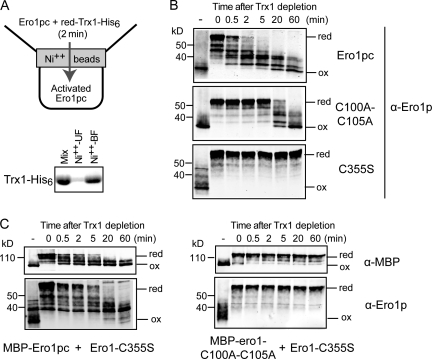Figure 2.
Pathways for Ero1p inactivation. (A) To test the ability of Ero1p to oxidize itself autonomously, 1 µM reduced (red) Ero1pc was prepared by incubation with 100 µM reduced His6-tagged Trx1 for 2 min and then passage through Ni2+ beads to remove Trx1. Trx1 depletion was confirmed by SDS-PAGE (Mix; initial mixture: Ni2+-BF [beads bound fraction] and Ni2+-UF [unbound fraction]). (B) Autonomous reoxidation (ox) of Ero1pc after removal of Trx1 occurs rapidly and efficiently but depends on a functional active site (C355), and efficient reoxidation depends on the shuttle disulfide (C100-C105). The first lane in each time course (−) shows the oxidation state of Ero1pc before reduction by Trx1. (C) Ero1pc, expressed as an MBP fusion (MBP-Ero1pc), can reoxidize Ero1pc-C355S in trans. An equal mixture of MBP-Ero1pc (or MBP-ero1-C100A-C105A; right) and Ero1pc-C355S was reduced by incubation with reduced Trx1 followed by Trx1 depletion. The time course of reoxidation of MBP-Ero1pc and Ero1pc-C355S was followed independently by separating MBP-Ero1pc and Ero1pc-C355S by size in SDS-PAGE and immunoblotting for MBP or Ero1.

